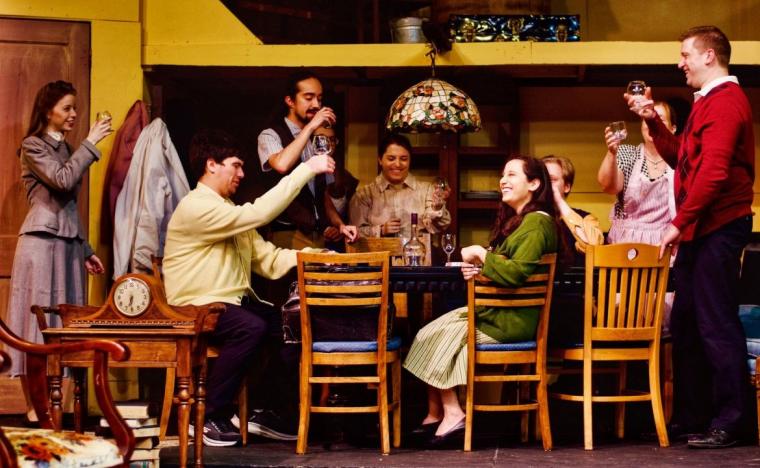
Emma Terronez and ensemble members in The Diary of Anne Frank
Eighty-one years ago, on August 4, in Amsterdam, eight people in hiding were found, arrested, interrogated, and taken to the death camp Auschwitz. They were just a few of thousands in the Netherlands who were ultimately massacred for being Jewish; just a few of millions of Jews, Poles, Romani, and others in Europe exterminated by the Nazis. A young woman's writings were among the accounts of the period to survive World War II, and Frances Goodrich and Albert Hackett's stage adaptation of these letters opened on Broadway in 1955. Wendy Kesselman adapted that script in 1997, and the horrifying story told in The Diary of Anne Frank is now being lovingly presented at Moline's Playcrafters Barn Theatre, directed by accomplished actor Elle Winchester.
Emma Terronez takes the role of budding journalist Anne, 13 years old when she went into hiding in "the secret annex." An energetic playfulness at the show's beginning starts her convincing portrayal. As time passes, Terronez also embodies Anne's idealism, intelligence, naïveté, belligerence, and enthusiasm, painting a full portrait of the author of the diary read 'round the world. The versatile Esteban Lopez plays her father Otto, a.k.a. "Pim," the organizer of this hideout: a now-idle section of the factory he managed until recently. Lopez tempers Otto's calm authority with warmth and kindness, while Jonna Hicks-Bird convincingly plays Anne's mother Edith, who clashes frequently with her outspoken daughter. Hicks-Bird often wears a stoic or worried demeanor, but when anguish breaks that mask, she reminds us of the constant terror of discovery they all face. Kaitlyn Knepper is Anne's older sister Margot – she's pleasant and soft-spoken, but eventually shows the strain of confinement, too.
On the other hand, the Van Daans, whom the Franks are in hiding with, display irritability almost from the start, and three wonderful actors portray this family. Victor Angelo plays the patriarch, Otto's business partner, with his gratitude at being included in this hiding place devolving quickly into varying degrees of crankiness. Mr. Van Daan seems to carry a great weight on his shoulders, and his wife, played by Amanda Wilson, is part of his burden. She's a spoiled, attention-craving nuisance, and Wilson brings some welcome hilarity to The Diary of Anne Frank's grimness. Michael Kintigh plays teenage Peter, who at first is understandably sullen and taciturn after having to leave his home for these subpar accommodations with near-strangers. Peter eventually thaws, and the change in his demeanor is heartwarming. Kintigh also turned in a delightful performance as Benedick in Genesius Guild's June production of Much Ado About Nothing, and I hope to see him onstage again soon.

Keegan Walker reveals multiple facets as Mr. Dussel. (Anne used this pseudonym for her dentist roommate in her diary; Dussel means "fool" in German.) They must allow one another private time, and it's understandable that an adult man and a young woman would bristle at having to share space. Walker's Dussel impressively loses his temper at times, but reminds us that he's human when speaking tenderly of his absent love, Charlotte. Lillian Dawn plays Miep and Drew DeKeyrel is Mr. Kraler – Otto's factory employees and friends who arranged the hiding place and brought supplies to the beleaguered group at great personal risk. Dawn is self-effacing and appealing as Miep, and DeKeyrel subdued and a bit gruff as Kraler.
Jackson Grubbs, Jaren Schoustra, and Shalom Moore, meanwhile, portray Nazis, and are scarily brutal when they raid the quarters at the end, brandishing guns and shouting. On Friday, they were less terrifying, earlier in the production, when marching in place – but I did admire their singing extensively in German, as well as the women singing "Baruch Atah Adonai" in Hebrew at Hanukkah. I appreciated these and other authentic bits, among them the western-European style pronunciation of names, as opposed to the Americanized ones we're used to. ("Anne," for example, is pronounced "Ah-nah" here.) Another fine touch is a bookcase placed at the bottom of the stairs to the theatre – the entrance to the secret annex was concealed with a similar bookcase. All told, Jaina Gliva's and Chris Sambdman's stage design was attractive, utilitarian, yet appropriately cramped and restrictive, especially upstage.

On opening night, weak spots in the production included a few apparently botched lighting cues, leaving actors in the dark with empty, well-lit spots on the set. Some actors spoke too softly throughout, and the momentum-interrupting effect of scene breaks could've been aided with sound – perhaps snippets of era-appropriate music or radio announcements. News broadcasts actually were heard, but some were recorded and others, oddly, delivered live.
Still, The Diary of Anne Frank remains a powerful experience. In the final scene, and with very effective staging by Winchester, Lopez's Otto – the only one of the hidden eight to survive the death camps – describes the fates of his family and friends with the perfect combination of restraint and anguish. It hurts deeply to think about their torments and deaths, as well as how their lives might've turned out if they'd never been terrorized at all. May we see all people as humans, as part of our worldwide family, and not as imagined threats.
The Diary of Anne Frank runs at the Playcrafters Barn Theatre (4950 35th Avenue, Moline IL) through August 10, and more information and tickets are available by calling (309)762-0330 and visiting Playcrafters.com.










